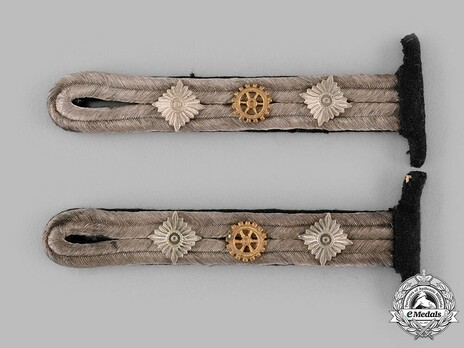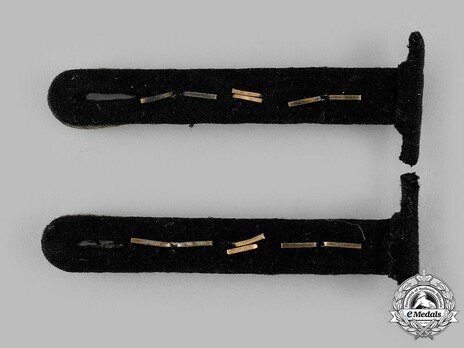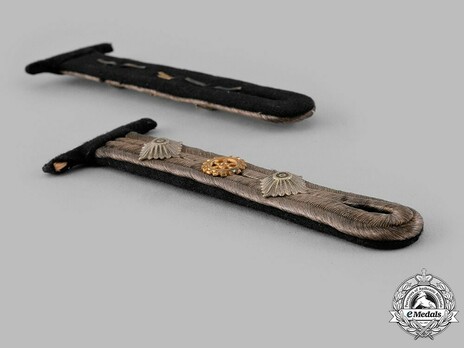Kriegsmarine Engineering Oberfähnrich Shoulder Boards
CATEGORY: Version
SKU: 21.GOR.03.02.02.05.001.001
Estimated market value:



Estimated market value:
A set of Kriegsmarine Oberfähnrich Engineer shoulder boards, each constructed of dark blue wool with a magnetic metal wire reinforcement, bearing two bands of silver aluminum wire piping, and pinned with two silvered bronze rank pips and a gilded bronze cogwheel, both unmarked and measuring 17 mm (w) x 115 mm (l), in near extremely fine condition.
The headgear, uniforms, and insignia worn by members of the Kriegsmarine were based upon the designs utilized by the Kaiserliche Marine (Imperial Navy) and the Reichsmarine of the Weimar Republic. The official regulations governing the uniforms of the Reichsmarine were issued on April 5, 1921, and they were embraced, with a few alterations, as the Kriegsmarine uniforms in 1935.
The first regulations concerning the shoulder boards of officers were issued in 1933, but they were altered several times throughout the interim years and during the war.
Shoulder boards or straps were first and foremost used to identify a soldier’s rank. In certain cases they would also identify the soldier’s branch and unit, and potentially his specific role/career.
Shoulder straps were worn by lower ranks, whereas shoulder boards were worn by higher ranks. The difference lies in the quality of the material, the more elaborate look of the shoulder boards, and the fact that shoulder boards were padded and therefore more stiff, while shoulder straps generally were not. For the sake of simplicity, the terms will be used interchangeably.
Shoulder straps differ in size due to varying production methods and materials, the amount of pips and cyphers they have to hold, and even the wearer’s shoulder size.
The Kriegsmarine shoulder boards were manufactured in three distinct styles, sew-in, slip-on, and pass-through. The boards on the tropical uniform were generally button-on.
The Kriegsmarine used four different uniform types, distinguishable by colour. The shoulder boards will differ from each other depending on what type of uniform they were intended for. The main uniform was navy blue in colour and features shoulder boards with a dark blue underlay. Shoulder boards for the white uniform are very similar, except that they have a white underlay. The brown tropical uniform and the field-grey uniform used mostly by Coastal Artillery units came with shoulder boards that somewhat differed from those of the blue and white uniforms, and will be covered towards the end of this description.
In the Kriegsmarine, shoulder boards were used by soldiers of every rank. An exception were the lowest ranks, the Enlisted Men (EMs), known collectively as Matrosen (seamen), who were only issued shoulder boards with the field-grey uniform and, on occasion, the tropical brown uniform.
Officer candidates only had specific shoulder boards for the blue and white uniform. With the field-grey and brown tropical uniform they wore the shoulder straps of the Obermaat and Maat ranks.
They wore silver shoulder cords (Schulterlitzen), made of a parallel flat cord with V-pattern threads. No underlay was necessary according to regulations, but they were frequently worn with a dark blue or white underlay, similar to the shoulder boards of officers. Career insignia cyphers were made of metal and gold-coloured. Rank pips were silvered. The rank of Oberfähnrich was identified by two pips, one above and one below the career insignia cypher, while the rank of Fähnrich was identified by having no pips.
Starting in May of 1944, cadets and officer candidates wore two loops of gold tress around the lower end of their shoulder straps with the blue and field-grey uniforms. With the brown tropical uniform the tress is cornflower-blue.

Comments
Sign in to comment and reply.


Scroll Top